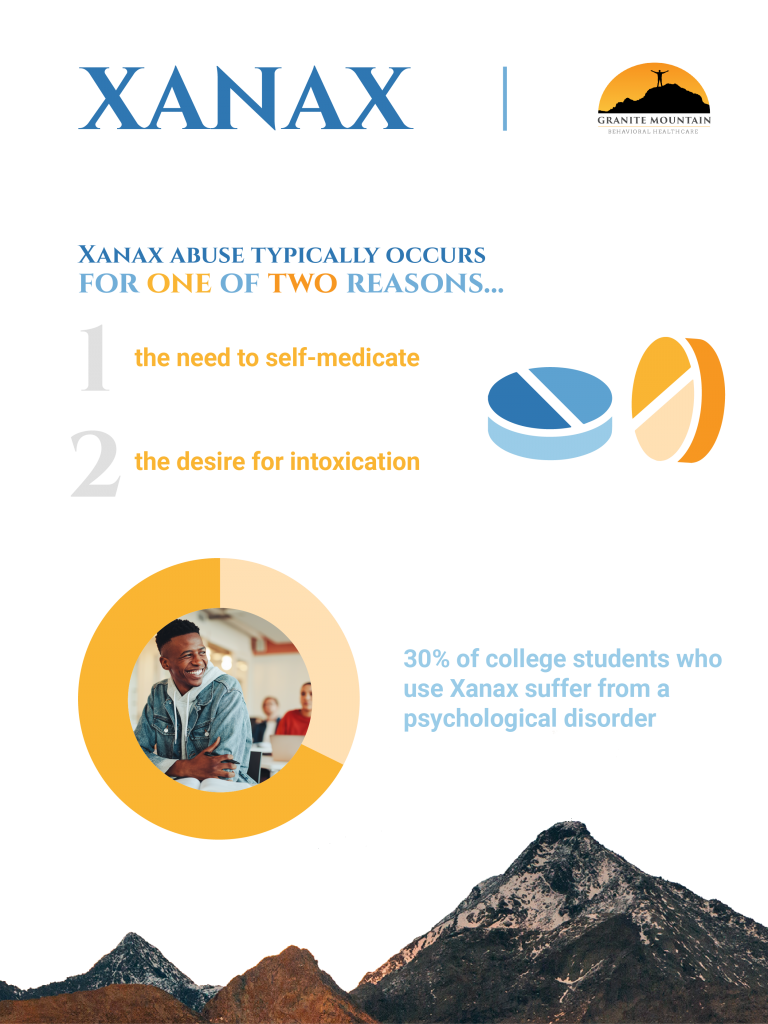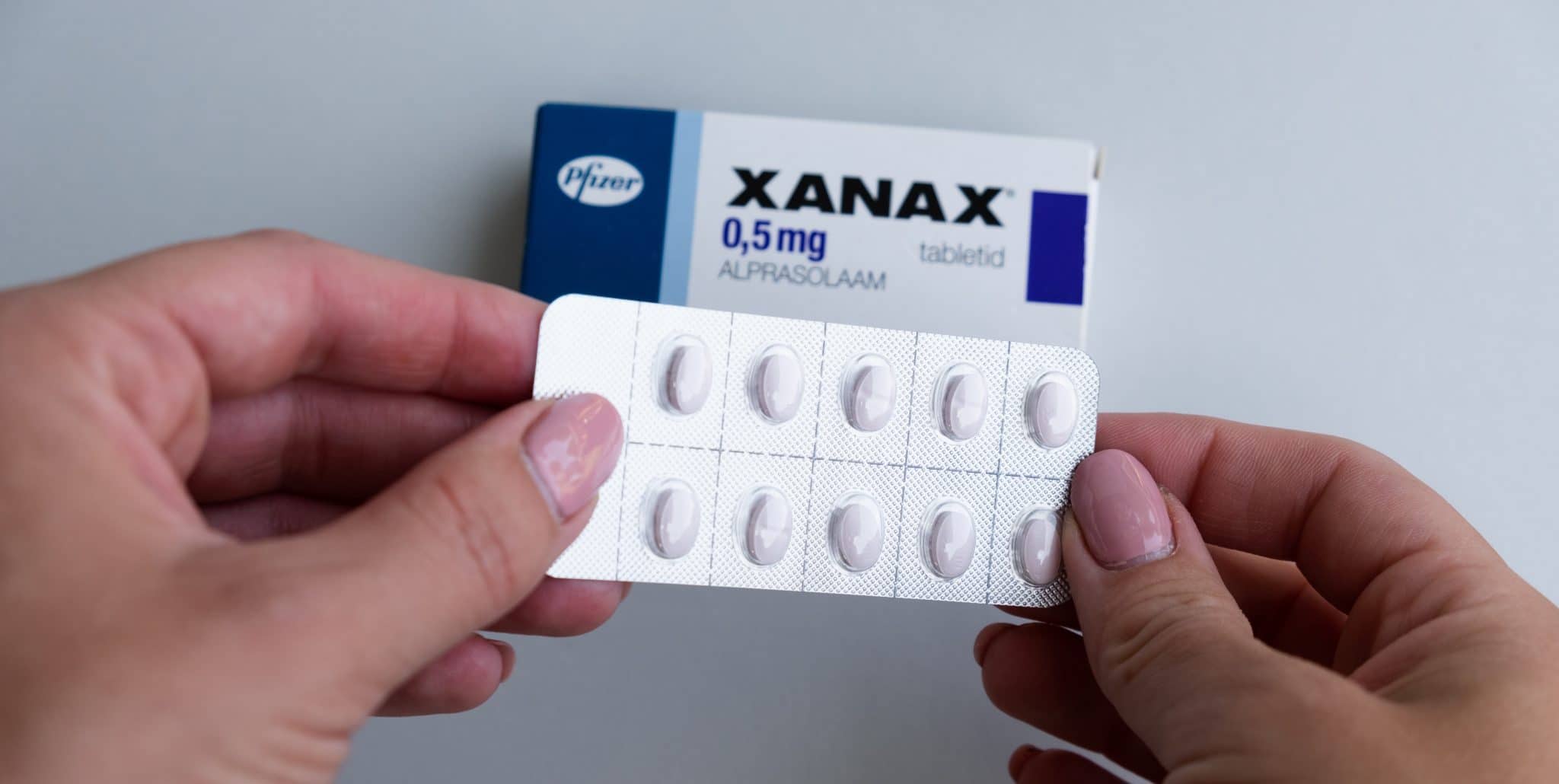Xanax is a highly addictive prescription medication that acts as a sedative. Although effective in treating the symptoms of several mental illnesses, the long-term effects of Xanax lead to serious problems. Developing a tolerance and dependency on the drug is a common occurrence that can fuel substance abuse and subsequently, addiction. Yet the harm can escalate from there, inducing cognitive impairment and even permanent brain damage.
Despite the risk of Xanax brain damage, the drug is still regularly administered. Yet short-term use is often recommended. Especially as more studies prove the potential for abuse and subsequent harm to the brain.
Medical professionals favor the smallest possible dose for no longer than several weeks, despite the risk of dependency and withdrawal. Regardless of effectiveness, it’s equally dangerous without moderation and supervision. Coming with the possibility of dangerous repercussions, addiction and abuse are at the top of the list.
Xanax Is A Prescription Medication
Xanax is intended to be a prescription-only medication used in the treatment of anxiety disorders and other mental illnesses. Xanax is a designer name for alprazolam, designed to promote relief from the physical and emotional symptoms of certain conditions. In fact, because of its high-quality sedating properties, it continues to be recommended and refilled at significantly increased rates.
Recent studies suggest that more than 48 million scripts are written for the drug each year. The popularity alone keeps Xanax relevant and easily attainable. However, because of the intended short-term nature of the medicine, the long-term effects of Xanax are easily overlooked.
What makes the risk of Xanax brain damage ever more disturbing, is the difficulty faced when weaning off the drug. Any medication that can change the way the brain operates, in this case, inducing sedation establishes the potential for uncomfortable withdrawal. Any deviation, in dosage, duration, or frequency, otherwise recommended by a physician, isn’t only harmful, but is considered drug abuse.
Why Is Xanax Still Available?
The unfortunate fact of the matter is that many individuals addicted to Xanax aren’t even aware until they’re without it. This is especially true for those liberally prescribed high doses, throwing caution to the wind. While Xanax can be beneficial for those suffering, Xanax brain damage will always be a risk. The long-term effects of Xanax to cope with extremely traumatic events, as in PTSD, isn’t without consequence. Essentially, when treating any illness using Xanax, the benefits must outweigh the risks. Unfortunately, with such a high risk, this doesn’t happen often.
Other illnesses that doctors treat with Xanax include:
- Anxiety
- Insomnia
- Obsessive-Compulsive Disorder (OCD)
- Post Traumatic Stress Disorder (PTSD)
- Panic Disorders
- Certain types of depression
- Seizure Disorders
- Bipolar Disorder
The good news is that there are many other effective and much safer alternatives to treat many of these illnesses. Opting for an alternative not only rules out the possibility of Xanax brain damage.
It also alleviates the long-term effects of Xanax, including tolerance and addiction. Regardless, when opting for Xanax as a means to treat any illness, it is important to follow proper dosing instructions. Likewise, stopping the medication should be done under the strict supervision of a physician, as withdrawal can be severe.
Xanax Abuse And Addiction
With Xanax, the potential for dependency and abuse is on the table, even with a prescription. However, even more, alarming is the illegal sale and use of the drug. Despite being easily obtained with a prescription, it can be puzzling to understand acquiring it illegally. But it happens often, and here’s why. Xanax abuse typically occurs for one of two reasons.
- The need to self-medicate
- The desire for intoxication
The need to self-medicate is complicated. On one hand, an individual may be attempting to soothe mental illness without the help of a professional. Alternatively, they may have been given Xanax at a certain dose short-term, but then forced to stop abruptly. Usually, this is the case when the doctor is trying to avoid the long-term effects of Xanax but induces withdrawal instead. This is why it’s important to take the proper precautions when halting this drug, as is performed in drug rehab.
Abusing Xanax as a means to party and feel good poses more than just the danger of becoming addicted. When combined with other substances, such as alcohol or other drugs, the interactions intensify. Any combination of substances can leave an individual more vulnerable to their surroundings, causing abrupt unconsciousness or temporary memory loss.
Teens And Xanax Brain Damage
Young adults in their teens and early ’20s are the highest impacted by the long-term effects of Xanax. Xanax abuse is more than twice as high among highschool aged teenagers. While the reasons for this are unlimited, there is one common misconception that stands out.
Many teens with Xanax addiction are under the impression that medications are safer than illegal drugs or alcohol. This is not at all true and combined with the overwhelming availability, is a complete disaster for youth community members.
Even fully-formed brains, typically occurring after the age of 25, are subject to the long-term effects of Xanax. While the concern is specifically placed on chronic abusers, the short-term effects of Xanax come with their warning.
The Short-Term Effects Of Xanax Abuse
The short-term effects of Xanax most often apply to chronic addicts and recreational abusers alike. Because the effects can be felt in as little as a few minutes after ingestion, short-term is usually most obvious. Even more hazardous is the abuse of Xanax when injected or snorted, increasing the potency and speed of onset.
Some of the short-term effects of Xanax abuse include:
- Slurred speech
- Confusion, disorientation, or euphoria
- Difficulty concentrating
- Becoming quickly agitated
- Changes in eating or appetite
- Feeling dizzy, fatigued, or unexpectedly needing to sleep
Individuals that have not yet built up a tolerance to Xanax will often feel these effects much stronger. Although it may take time for Xanax brain damage to occur, drugs abused in large quantities, have debilitating effects. Even long-term Xanax abusers can experience these symptoms with higher than normal doses, making severe withdrawal even more likely.
Long-Term Effects Of Xanax Abuse
Understanding why tolerance and dependency happen, certainly explains the long-term effects of Xanax. Although suggesting that the long-term effects of Xanax take time to develop, the timeline is relatively short. In as little as 6-8 weeks, GABA production can be completely different. While adjusting and recovering from addiction, participation in individual therapy will be helpful. Learning to accept and cope without the use of drugs and dependency is important to maintain sobriety in recovery.
The results of Xanax brain damage may include but are not limited to:
- Memory loss or impairment and lowered IQ averages
- Vision deterioration or difficulty determining spatial orientation
- Difficulty with problem solving and concentration or attention to detail
- Loss of verbal skills or trouble learning new ones
- Slower response time to physical and mental stimuli
Tolerance build-up and the need for higher doses more frequently often lead to the list of long-term effects of Xanax. Like any substance with the potential for dependency, after some time, the body will adjust. Now, needing more of the drug to feel anything comes second to only avoiding the downfall that occurs in withdrawal.
How Xanax Affects The Brain
Xanax is in the benzodiazepine class of controlled substances. It affects the central nervous system and forces a response. The response is sedation, relaxation, or feelings of calm, despite stressful scenarios. This occurs in response to the enhancement of a neurotransmitter called GABA, which is naturally found in the brain.
GABA is specifically responsible for inhibiting messages that could overwhelm the brain thereby inducing calm. When augmented, sedation and relaxation are increased, resulting in the reduction of anxiety or disruptive thoughts. Additionally, by interpreting the lack of anxiety as a good thing, Xanax may inspire the pleasure centers of the brain.
Once the brain perceives using Xanax as a means of reward or feels good, dependency and addiction are soon to follow. However, more and more will be needed over time due to the compensation of brain chemicals to maintain balance. The alteration of brain chemicals sets the long-term effects of Xanax in motion, and some are irreversible.
Cognitive-behavioral therapy can help to break these associations over time, but only after drug use has stopped and detox completed. Replacing addictive behaviors with sober actions and beneficial thoughts helps to mentally cope and set recovery goals. This type of treatment can begin within the early stages of treatment, as to implement the lessons throughout rehab.
The Symptoms And Dangers Of Xanax Withdrawal
As long as the function of the brain relies on the presence of Xanax, it will react accordingly. It will decrease the amount of GABA it makes naturally because Xanax has encouraged overproduction over time. Withdrawal sets in quickly, as soon as hours to days after the last dose, and more quickly with severe dependency.
Now, without Xanax, there will be much less GABA than needed, inducing feelings of panic and anxiousness as a result. Medical detox at rehab makes the experience as safe as possible, and can usually offer remedies for several symptoms. Professional care is especially important for those experiencing seizures induced by withdrawal, as it is common after abusing Xanax.
Some other symptoms of the long-term effects of Xanax include:
- Changes to cognition or mental status
- Difficulty falling or staying asleep
- Paranoia or delusional thoughts
- Greater risk of seizures
- Mood Swings
- Dizziness and disorientation
- Seizures, muscle spasms, and uncontrollable movement
Fortunately, many of these long-term effects are not permanent and can resolve after around 5 months post-detox. Getting help from a rehab increases the rates of recovery, and decreases the chances of perpetual dysfunction. However, conditions related to Xanax brain damage are much longer-lasting, if not permanent, and some can be debilitating.
Dual Diagnosis And Xanax Addiction
Many Xanax addicts find themselves with the need for help to detox. This is because, in cases of dual-diagnosis, they are facing more than one illness at the same time. When abusing Xanax to treat mental illness, legally or illegally, many individuals are unable to stop using it because of tolerance. Now, they need higher and higher doses to find relief from their mental illness. On top of that, without it, they become ill, the cravings start, and the symptoms of psychological illness will resurface.
College-aged students are at a particularly high risk of dual diagnosis and Xanax abuse. More than 30% of students on campus who admit to using Xanax, with or without prescription, suffer from psychological illness. Compared to the only 15% who participated in Xanax abuse recreationally. With the stakes of scholastic success prioritized, there is simply no time to experience withdrawal, creating a cycle.
This makes getting professional rehab care for dual-diagnosis critical to recovery. The safety of detoxing within the facility allows for proper care to be administered and offers safety and privacy. Then, promptly after detox, treatment for addiction and mental illness can be focused on separately, but at the same time.
Treatment Options For The Long-Term Effects Of Xanax Addiction
The best option for treating individuals that suffer from Xanax abuse and addiction is an intensive rehab program. Especially when facing the long-term effects of Xanax use, there is a significant road ahead after detox. Choosing a rehab program that offers partial hospitalization and intensive outpatient treatment options enables better coping skills moving forward. This way there will be an option for learning and supporting every step of the way.
Another option favored by many working to recover from addiction is peer-orientated treatment programs. Because of the feelings of vulnerability often associated with addiction, substance abuse therapy, and recovery, a relatable community focuses on healing.
Gender-specific programs allow for individuals to better associate their addictive behaviors with increased relevance and more effective community coping. With accountability and encouragement incorporated into the structure of the treatment, working through the long-term effects of Xanax is encouraged.
Facing The Long-Term Effects Of Xanax Through Rehab
Xanax abuse typically occurs for one of two reasons; As an attempt to self-medicate, or to feel the euphoria. Abusing Xanax as a means to party and feel good poses more than just the danger of becoming addicted. Individuals prescribed medications without proper outlets to detox are also at risk. There are long-term effects of Xanax abuse that can be lifelong or even debilitating.
The cycle of suffering from addiction and experiencing withdrawal does not have to last forever. Getting help lowers the risks of brain damage associated with Xanax abuse, and can put you back in control. Reach out for more information on how rehab can help. You can live a sober life after Xanax addiction, and you can get help to get there. Connect with us today to get started and choose recovery for you; You are worth it.



